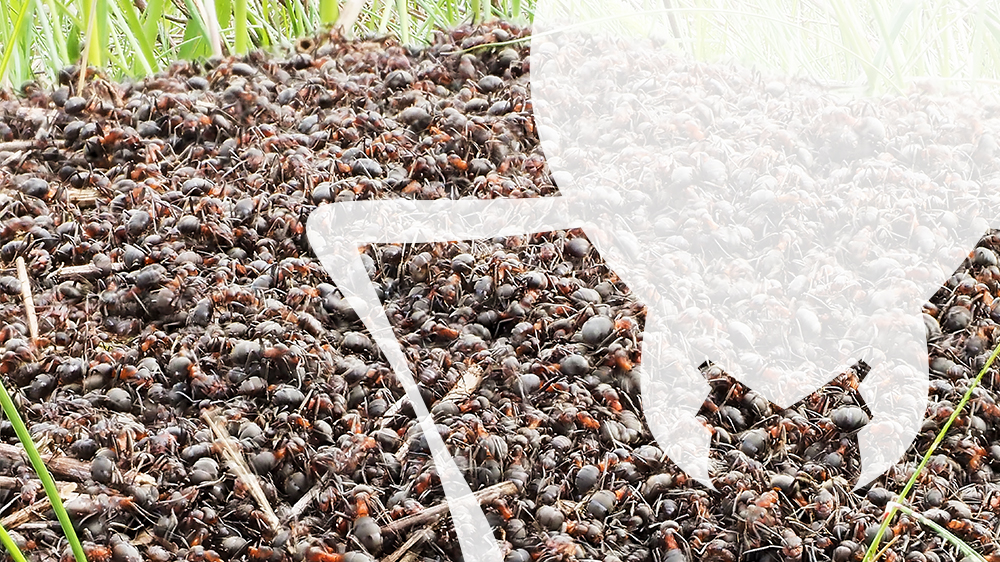
How to ruin a backyard barbecue? Stepping into an aggressive anthill. These industrious insects can quickly establish colonies in and around your living spaces. While some ants are merely a nuisance, others can cause structural damage or deliver painful bites. Ant identification is the first step in protecting your home from these pests. This guide will help you identify common ant species so you can take appropriate action.
If you’re seeing ant colonies around your home or business, it’s time to take action. Accurate ant identification is the first step in determining the right treatment. Learn more about our Residential Pest Control and Commercial Pest Control services to keep your property pest-free.
Common Household Ants – Tips for Ant Identification
Red Imported Fire Ants – Identification and Safety Tips
Identifying Features
Red imported fire ants are reddish-brown with darker abdomens and measure 2–6 mm in length, varying by caste. They have two nodes between the thorax and abdomen, and their antennae have 10 segments with a two-segmented club. Their most notorious feature isn’t visible—it’s their painful sting that produces a burning sensation followed by a pustule.
Where are they found and what are they looking for?
Fire ants prefer sunny, open areas like your lawn and build distinctive mound nests that can be up to 18 inches tall. They’re aggressive defenders of their nests and will swarm anything that disturbs their mound. They feed on a variety of foods, including other insects, seeds, and sweet substances like honeydew from aphids. For first aid and safety tips for fire ant stings, see NIOSH: Protecting Yourself from Stinging Insects.
Carpenter Ants – Ant Identification for Homeowners
Identifying Features
Carpenter ants are among the largest ants in North America, measuring 6–12 mm in length. They are typically black, red, or a combination of both colors. Their most distinctive feature is their heart-shaped head when viewed from the front and their thorax, which has an evenly rounded upper profile without spines. Worker ants have a single node between the thorax and abdomen.
Where are they found and what are they looking for?
Carpenter ants are found worldwide, primarily in wooded areas, trees, and wooden structures. Proper ant identification can help you distinguish them from other wood-infesting insects. Unlike termites, they don’t eat wood but excavate it to build their nests. They’re particularly attracted to moist or damaged wood in homes, such as around leaky pipes, windows, doors, and roof eaves. When disturbed, they may emit a formic acid smell.
Crazy Ants – Recognizing Crazy Ants in Your Home

Identifying Features
Tawny crazy ants are invasive ants from South America. They have become a significant nuisance in the last few years here in Louisiana. They get their name from their erratic, unpredictable movement patterns. They are small (3 mm) with long legs and antennae. Their bodies are usually reddish-brown. These are easy to identify, often gathering in large groups to cover an area like a blanket! They’re difficult to control due to their large numbers, lack of centralized nests, multiple queens, and ability to detoxify common insecticides, but we have a proven remedy.
Where are they found and what are they looking for?
Crazy ants form colonies in both dry and moist environments, including soil, tree cavities, trash, under stones, and inside homes. They also do not build centralized nests, instead forming colonies under almost any object that retains moisture such as tree stumps, potted plants, rocks, soil, or even concrete. They’re omnivorous and are particularly attracted to sweet substances within plants or over-ripe fruit.
Odorous House Ants – Identification and Prevention
Identifying Features
Odorous house ants are small (2.5–3.5 mm) and dark brown to black. Their most distinctive feature is the strong, rotten coconut-like smell they emit when crushed, giving them their name. They have a single node on their petiole that’s hidden by their abdomen when viewed from above.
Where are they found and what are they looking for?
These ants typically nest in wall voids, under floors, behind baseboards, and near heaters or water pipes. Outdoors, they nest in soil under stones, logs, and mulch. They’re highly attracted to sweet foods and will also consume proteins. Their colonies can contain thousands of workers with multiple queens.
Pavement Ants – Ant Identification Made Easy
Identifying Features
Pavement ants are small, measuring only 2.5–4 mm in length. They are dark brown to black in color with lighter-colored legs and antennae. Their most distinctive features are the parallel lines on their head and thorax and two small spines on the back of their thorax. They move slowly and will form trails to their food sources.
Where are they found and what are they looking for?
As their name suggests, pavement ants typically nest under sidewalks, driveways, and building foundations. Inside homes, they may nest in walls, under floors, or in insulation. Pavement ants are omnivorous and will eat almost anything, including greasy foods, meats, sweets, fruits, and even other insects.
Pharaoh Ants – Ant Identification Indoors

Identifying Features
Pharaoh ants are tiny (1.5–2 mm) and light yellow to reddish-brown with a darker abdomen. They have 12-segmented antennae with a three-segmented club and two nodes between their thorax and abdomen. Their small size and light coloration make them distinctive.
Where are they found and what are they looking for?
These ants thrive in warm, humid environments and are commonly found in hospitals, apartments, hotels, and grocery stores. They nest in hard-to-reach areas like wall voids, behind baseboards, and under floors. Pharaoh ants are omnivorous but show a preference for proteins and sweets. They’re notorious for their ability to spread diseases in healthcare settings.
Argentine Ants – Ant Identification for Invasive Species
Identifying Features
Argentine ants are small to medium-sized (2.5–3 mm) and light to dark brown. They have a single node between their thorax and abdomen and antennae with 12 segments. They don’t have stingers and don’t bite, but they do emit a musty odor when crushed.
Where are they found and what are they looking for?
Originally from South America, Argentine ants have become invasive in many regions. They form massive super colonies with multiple queens and can displace native ant species. They typically nest in moist soil near buildings or under debris. Argentine ants are attracted to sweet foods and protect honeydew-producing insects like aphids.
Little Black Ants – How to Tell Them Apart

Identifying Features
As their name suggests, little black ants are small (1.5–2 mm) and shiny black. They have two nodes between their thorax and abdomen and 12-segmented antennae with a club. Although common, they’re often confused with other small black ant species.
Where are they found and what are they looking for?
Little black ants nest outdoors in soil, under rocks, in rotting wood, and in masonry cracks. Indoors, they are often found in the kitchen and may nest in woodwork or wall voids. They feed on a variety of foods including sweets, oils, meats, fruits, and other insects. Their trails are often visible as they travel to and from food sources.
Acrobat Ants – Recognizing Acrobat Ants
Identifying Features
Acrobat ants are named for their habit of raising their heart-shaped abdomen over their head when threatened, resembling an acrobatic pose. They’re 2.5–3 mm long and range from light brown to black. They have a pair of spines on their thorax and a two-segmented petiole.
Where are they found and what are they looking for?
These ants commonly nest in dead or water-damaged wood, insulation, and wall voids. Outdoors, they inhabit tree cavities, stumps, and under stones. Acrobat ants feed on sweets and proteins, including honeydew from aphids and dead insects. They often follow electrical wires and plumbing lines to enter buildings.
Ghost Ants – Identification Tips for Ghost Ants
Identifying Features
Ghost ants are tiny (1.5 mm) with dark heads and thoraxes contrasting with their pale, nearly translucent abdomens and legs. This coloration makes them difficult to see on light surfaces, hence their ghostly name. When crushed, they emit a rotten coconut-like odor similar to odorous house ants.
Where are they found and what are they looking for?
Ghost ants prefer warm, humid environments and are common in tropical and subtropical regions. They nest both indoors and outdoors, often in plant pots, between books, behind baseboards, and inside wall voids. They’re strongly attracted to sweets but will also consume proteins. Their colonies can contain multiple queens, allowing for rapid expansion.
The Bug Man Will Handle the Infestation
If you suspect any ant infestation in your home, the most effective approach is to work with a professional pest control company—they will handle the ant identification for you. Proper ant identification is crucial, as different ant species require different treatment strategies, and misidentification can lead to ineffective control measures. Contact The Bug Man to eliminate ant problems today—so you can get back to enjoying your home.
Don’t let ants take over your property. Our expert Residential Pest Control and Commercial Pest Control services are designed to identify the specific ant species you’re dealing with and implement targeted treatment plans. Schedule your appointment today!


